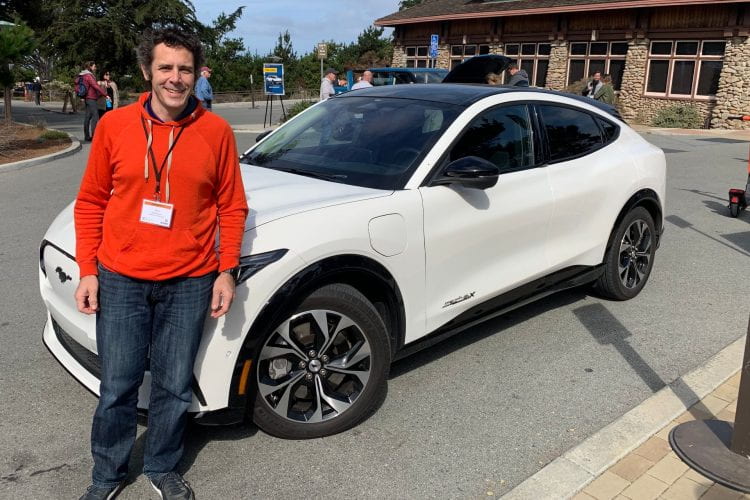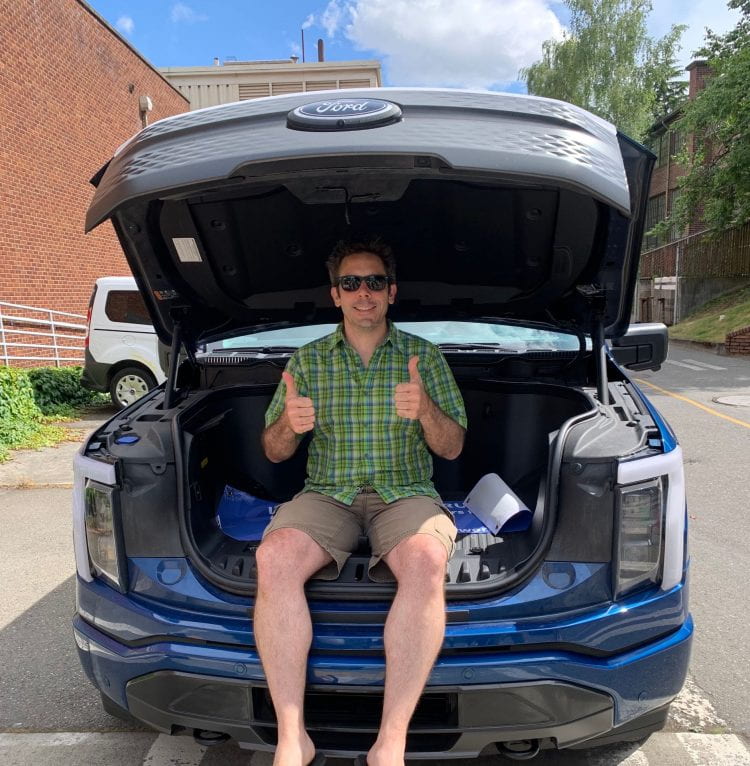July 7, 2022
Will bad infrastructure sink the EV market?

Don MacKenzie
Yesterday the UW got a visit from Ford, and I got the chance to check out a couple of the company’s new electric offerings. First up was the Mustang Mach-E. The Mach-E has been in production since 2020 and I’d previously driven one at a conference last fall:

Mustang Mach-E
But this one was special: it was a GT trim and just the third unit the company had produced. And oh boy, did it move. I tried getting a video of the cackles of delight from the carload of professors, but I was too busy being pinned to the back of my seat.
Next up was the F-150 Lightning. We took it for a spin in one of the UW’s large, empty parking lots, and as you can tell from my grin, it did not disappoint.

Sitting in the “frunk” of the F-150 Lightning.
The F-150 Lightning has the massive, instant acceleration so characteristic of EVs, with the capability and comfort we come to expect from America’s most popular vehicle. I’ve been saying for a while that these products are absolutely game-changing for the EV market, and yesterday’s drive confirmed that. Here we have one of the auto industry’s most storied manufacturers betting its two most valuable brands – Mustang and the F series – on the success of EV technology.
If it were only about the product, I have little doubt at this point that we would be making a rapid and permanent switch to EVs across most if not all consumer segments. Unfortunately, OEMs are staring down a big risk: sparse and unreliable infrastructure. A recent study in the Bay Area reported that more than 25% of public DC fast charging (DCFC) plugs in the San Francisco Bay Area were non-functional. As the EV market grows from early adopters to the majority, I expect consumers will be much less forgiving of the headaches that come from malfunctioning charging stations. In fact, I would bet that many buyers will swear off EVs for good after one time getting stranded at a broken charger. That could delay the EV transition for decades.
The federal infrastructure bill passed last year includes billions of dollars for new fast-charging infrastructure along the federal highway network. As states distribute these funds to infrastructure developers, they will need to ensure there are strong, enforceable provisions to ensure high charger reliability. Tesla has shown that it is technically possible to build a network with high reliability. It remains to be seen if maturing technology and the entry of major brands into the charging market can improve the charging experience quickly enough to support continued growth in the non-Tesla EV market. The public and private sectors will need to work together to ensure that federal dollars are spent as smartly as possible, to create a robust and reliable fast charging network and ensuring a good return on taxpayers’ investments.
Recent Comments